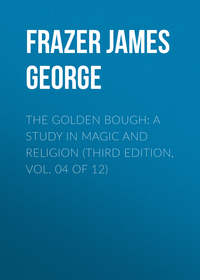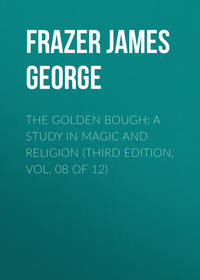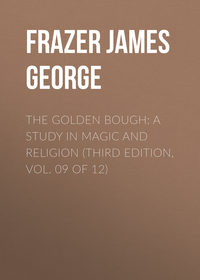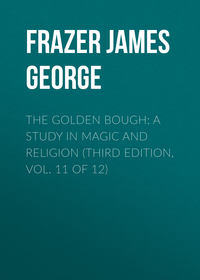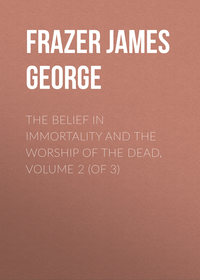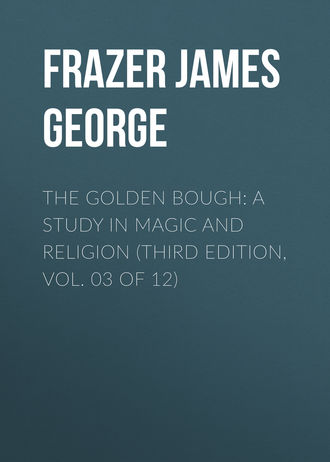 полная версия
полная версияThe Golden Bough: A Study in Magic and Religion (Third Edition, Vol. 03 of 12)
1106
J. G. Dalyell, ll.cc.
1107
Rev. Dr. Th. Bisset, in Sir John Sinclair's Statistical Account of Scotland, v. (Edinburgh, 1793) p. 83. In his account of the second tour which he made in Scotland in the summer of 1772, Pennant says that “the precaution of loosening every knot about the new-joined pair is strictly observed” (Pinkerton's Voyages and Travels, iii. 382). He is here speaking particularly of the Perthshire Highlands.
1108
Pennant, “Tour in Scotland,” Pinkerton's Voyages and Travels, iii. 91. However, at a marriage in the island of Skye, the same traveller observed that “the bridegroom put all the powers of magic to defiance, for he was married with both shoes tied with their latchet” (Pennant, “Second Tour in Scotland,” Pinkerton's Voyages and Travels, iii. 325). According to another writer the shoe-tie of the bridegroom's right foot was unloosed at the church-door (Ch. Rogers, Social Life in Scotland, iii. 232).
1109
Eijüb Abela, “Beiträge zur Kenntniss abergläubischer Gebräuche in Syrien,” Zeitschrift des deutschen Palaestina-Vereins, vii. (1884) pp. 91 sq.
1110
Georgeakis et Pineau, Folk-lore de Lesbos, pp. 344 sq.
1111
E. Doutté, Magie et religion dans l'Afrique du Nord, pp. 288-292.
1112
“Eenige mededeelingen betreffende Rote door een inlandischen Schoolmeester,” Tijdschrift voor Indische Taal- Land- en Volkenkunde, xxvii. (1882) p. 554; N. Graafland, “Eenige aanteekeningen op ethnographisch gebied ten aanzien van het eiland Rote,” Mededeelingen van wege het Nederlandsche Zendelinggenootschap, xxxiii. (1889) pp. 373 sq.
1113
J. Spieth, Die Ewe-Stämme, p. 533.
1114
M. Jastrow, The Religion of Babylonia and Assyria, pp. 268, 270.
1115
J. G. Dalyell, Darker Superstitions of Scotland, p. 307.
1116
Al Baidawī's Commentary on the Koran, chap. 113, verse 4. I have to thank my friend Prof. A. A. Bevan for indicating this passage to me, and furnishing me with a translation of it.
1117
E. Palmer, “Notes on some Australian Tribes,” Journal of the Anthropological Institute, xiii. (1884) p. 293. The Tahitians ascribed certain painful illnesses to the twisting and knotting of their insides by demons (W. Ellis, Polynesian Researches,2 i. 363).
1118
Pliny, Nat. Hist. xxviii. 48.
1119
C. Fossey, La Magie assyrienne (Paris, 1902), pp. 83 sq.; R. Campbell Thompson, Semitic Magic (London, 1908), pp. 164 sqq.
1120
R. Campbell Thompson, Semitic Magic, pp. 168 sq.
1121
E. O'Donovan, The Merv Oasis (London, 1882), ii. 319.
1122
J. Spieth, Die Ewe-Stämme, p. 531.
1123
R. C. Maclagan, M.D., “Notes on Folklore Objects collected in Argyleshire,” Folk-lore, vi. (1895) pp. 154-156. In the north-west of Ireland divination by means of a knotted thread is practised in order to discover whether a sick beast will recover or die. See E. B. Tylor, in International Folk-lore Congress, 1891, Papers and Transactions, pp. 391 sq.
1124
R. Chambers, Popular Rhymes of Scotland, New Edition, p. 349. Grimm has shewn that the words of this charm are a very ancient spell for curing a lame horse, a spell based on an incident in the myth of the old Norse god Balder, whose foal put its foot out of joint and was healed by the great master of spells, the god Woden. See J. Grimm, Deutsche Mythologie,4 i. 185, ii. 1030 sq. Christ has been substituted for Balder in the more modern forms of the charm both in Scotland and Germany.
1125
W. Crooke, Popular Religion and Folk-lore of Northern India (Westminster, 1896), i. 279.
1126
Virgil, Ecl. viii. 78-80. Highland sorcerers also used three threads of different colours with three knots tied on each thread. See J. G. Dalyell, Darker Superstitions of Scotland, p. 306.
1127
J. Wellhausen, Reste arabischen Heidentums2 (Berlin, 1897), p. 163.
1128
Dudley Kidd, The Essential Kafir, p. 263.
1129
C. Velten, Sitten und Gebräuche der Suaheli (Göttingen, 1903), p. 317.
1130
David Leslie, Among the Zulus and Amatongas (Edinburgh, 1875), p. 147.
1131
Gríhya-Sûtras, translated by H. Oldenberg, part i. p. 432, part ii. p. 127 (Sacred Books of the East, vols. xxix., xxx.).
1132
J. Shooter, The Kafirs of Natal and the Zulu Country (London, 1857), pp. 217 sq.
1133
E. Aymonier, Notes sur le Laos (Saigon, 1885), pp. 23 sq.
1134
Vetter, in Mitteilungen der geographischen Gesellschaft zu Jena, xii. (1893) p. 95.
1135
W. R. S. Ralston, Songs of the Russian People, pp. 388-390.
1136
Ovid, Fasti, ii. 577 sqq.; compare W. Warde Fowler, Roman Festivals of the Period of the Republic, pp. 309 sq.
1137
Geoponica, i. 14.
1138
M. Abeghian, Der armenische Volksglaube, p. 115.
1139
M. Abeghian, op. cit. p. 91.
1140
V. Titelbach, “Das heilige Feuer bei den Balkanslaven,” Internationales Archiv für Ethnographie, xiii. (1900) p. 3.
1141
A. Heinrich, Agrarische Sitten und Gebräuche unter den Sachsen Siebenbürgens (Hermannstadt, 1880), p. 9.
1142
C. J. R. Le Mesurier, “Customs and Superstitions connected with the Cultivation of Rice in the Southern Province of Ceylon,” Journal of the Royal Asiatic Society, N.S., xvii. (1885) p. 371.
1143
J. G. Dalyell, Darker Superstitions of Scotland, p. 307.
1144
J. Brand, Popular Antiquities, ii. 231 (Bohn's edition); R. Hunt, Popular Romances of the West of England, p. 379; T. F. Thiselton Dyer, English Folk-lore, pp. 229 sq. On the other hand the Karaits, a Jewish sect in the Crimea, lock all cupboards when a person is in the last agony, lest their contents should be polluted by the contagion of death. See S. Weissenberg, “Die Karäer der Krim,” Globus, lxxxiv. (1903) p. 143.
1145
Extract from The Times of 4th September 1863, quoted in Folk-lore, xix. (1908) p. 336.
1146
M. Merker, Die Masai (Berlin, 1904), p. 98.
1147
H. Runge, “Volksglaube in der Schweiz,” Zeitschrift für deutsche Mythologie und Sittenkunde, iv. (1859) p. 178, § 25. The belief is reported from Zurich.
1148
J. G. Campbell, Witchcraft and Second Sight in the Highlands and Islands of Scotland, p. 174; id., Superstitions of the Highlands and Islands of Scotland, p. 241.
1149
E. Gerard, The Land beyond the Forest, i. 208.
1150
R. F. Kaindl, “Volksüberlieferungen der Pidhireane,” Globus, lxxiii. (1898) p. 251.
1151
A. C. Hollis, The Nandi (Oxford, 1909), pp. 89 sq. The tying and untying of magic knots was forbidden by the Coptic church, but we are not told the purposes for which the knots were used. See Il Fetha Nagast o legislazione dei re, codice ecclesiastico e civile di Abissinia, tradotto e annotato da Ignazio Guidi (Rome, 1899), p. 140.
1152
For examples see Horace, Sat. i. 8, 23 sq.; Virgil, Aen. iii. 370, iv. 509; Ovid, Metam. vii. 182 sq.; Tibullus, i. 3. 29-32; Petronius, Sat. 44; Aulus Gellius, iv. 3. 3; Columella, De re rustica, x. 357-362; Athenaeus, v. 28, p. 198 e; Dittenberger, Sylloge inscriptionum Graecarum,2 Nos. 653 (lines 23 sq.) and 939; Ch. Michel, Recueil d'inscriptions grecques, No. 694. Compare Servius on Virgil, Aen. iv. 518, “In sacris nihil solet esse religatum.”
1153
Ovid, Fasti, iii. 257 sq.
1154
Thucydides, iii. 22.
1155
Schol. on Pindar, Pyth. iv. 133.
1156
Virgil, Aen. vii. 689 sq.
1157
Pindar, Pyth. iv. 129 sqq.: Apollonius Rhodius, Argonaut. i. 5 sqq.; Apollodorus, i. 9. 16.
1158
Artemidorus, Onirocrit. iv. 63. At Chemmis in Upper Egypt there was a temple of Perseus, and the people said that from time to time Perseus appeared to them and they found his great sandal, two cubits long, which was a sign of prosperity for the whole land of Egypt. See Herodotus, ii. 91.
1159
Gazette archéologique, 1884, plates 44, 45, 46 with the remarks of De Witte and F. Lenormant, pp. 352 sq. The skin on which the man is crouching is probably the so-called “fleece of Zeus” (Διὸς κώδιον), as to which see Hesychius and Suidas, s. v.; Polemo, ed. Preller, pp. 140-142; C. A. Lobeck, Aglaophamus, pp. 183 sqq. Compare my note on Pausanias, ii. 31. 8.
1160
Virgil, Aen. iv. 517 sqq.
1161
I. Goldziher, “Der Dîwân des Garwal b. Aus Al-Hutej' a,” Zeitschrift der Deutschen Morgenländischen Gesellschaft, xlvi. (1892) p. 5.
1162
See Servius, on Virgil, Aen. iii. 370: “In ratione sacrorum par est et animae et corporis causa: nam plerumque quae non possunt circa animam fieri fiunt circa corpus, ut solvere vel ligare, quo possit anima, quod per se non potest, ex cognatione sentire.”
1163
Livy, i. 18. 7.
1164
“UNUM EXUTA PEDEM quia id agitur, ut et ista solvatur et implicetur Aeneas,” Servius, on Virgil, Aen. iv. 518.
1165
“On a Far-off Island,” Blackwood's Magazine, February 1886, p. 238.
1166
Clement of Alexandria, Strom. v. 5. 28, p. 662, ed. Potter; Jamblichus, Adhortatio ad philosophiam, 23; Plutarch, De educatione puerorum, 17. According to others, all that Pythagoras forbade was the wearing of a ring on which the likeness of a god was engraved (Diogenes Laertius, viii. 1. 17; Porphyry, Vit. Pythag. 42; Suidas, s. v. Πυθαγόρας); according to Julian a ring was only forbidden if it bore the names of the gods (Julian, Or. vii. p. 236 d, p. 306 ed. Dindorf). I have shewn elsewhere that the maxims or symbols of Pythagoras, as they were called, are in great measure merely popular superstitions (Folk-lore, i. (1890) pp. 147 sqq.).
1167
This we learn from an inscription found on the site. See Ἐφημερὶς ἀρχαιολογική, Athens, 1898, col. 249; Dittenberger, Sylloge inscriptionum Graecarum,2 No. 939.
1168
Ovid, Fasti, iv. 657 sq.
1169
I. V. Zingerle, Sitten, Bräuche und Meinungen des Tiroler Volkes,2 p. 3.
1170
J. Scheffer, Lapponia (Frankfort, 1673), p. 313.
1171
R. F. Kaindl, Die Huzulen (Vienna, 1894), p. 89; id., “Viehzucht und Viehzauber in den Ostkarpaten,” Globus, lxix. (1896) p. 386.
1172
W. Crooke, Popular Religion and Folk-lore of Northern India (Westminster, 1896), ii. 13, 16.
1173
M. Merker, Die Masai (Berlin, 1904), p. 143.
1174
M. Merker, op. cit. pp. 200 sq., 202; compare, id. p. 250.
1175
Above, p. 267.
1176
Above, pp. 32, 51.
1177
Above, p. 31.
1178
De la Borde, “Relation de l'origine, etc., des Caraibes sauvages,” p. 15, in Recueil de divers voyages faits en Afrique et en l'Amérique (Paris, 1684).
1179
A considerable body of evidence as to rings and the virtues attributed to them has been collected by Mr. W. Jones in his work Finger-ring Lore (London, 1877). See also W. G. Black, Folk-medicine, pp. 172-177.
1180
Aulus Gellius, x. 15. 8. See above, p. 14.
1181
Marcellinus on Hermogenes, in Rhetores Graeci, ed. Walz, iv. 462; Sopater, ibid. viii. 67.
1182
Demosthenes, Contra Androt. 68, p. 614; P. Foucart, Le Culte de Dionysos en Attique (Paris, 1904), p. 168.
1183
H. A. Oldfield, Sketches from Nipal (London, 1880), ii. 342 sq.
1184
Arrian, Anabasis, ii. 3; Quintus Curtius, iii. 1; Justin, xi. 7; Schol. on Euripides, Hippolytus, 671.
1185
Public talismans, on which the safety of the state was supposed to depend, were common in antiquity. See C. A. Lobeck, Aglaophamus, pp. 278 sqq., and my note on Pausanias, viii. 47. 5.
1186
On the primitive conception of the relation of names to persons and things, see E. B. Tylor, Early History of Mankind,3 pp. 123 sqq.; R. Andree, Ethnographische Parallelen und Vergleiche (Stuttgart, 1878), pp. 165 sqq.; E. Clodd, Tom-tit-tot (London, 1898), pp. 53 sqq., 79 sqq. In what follows I have used with advantage the works of all these writers.
1187
J. Mooney, “Sacred Formulas of the Cherokees,” Seventh Annual Report of the Bureau of Ethnology (Washington, 1891), p. 343.
1188
E. W. Nelson, “The Eskimo about Bering Strait,” Eighteenth Annual Report of the Bureau of American Ethnology, part i. (Washington, 1899) p. 289.
1189
A. C. Kruijt, “Van Paloppo naar Posso,” Mededeelingen van wege het Nederlandsche Zendelinggenootschap, xlii. (1898) pp. 61 sq.
1190
Professor (Sir) J. Rhys, “Welsh Fairies,” The Nineteenth Century, xxx. (July-December 1891) pp. 566 sq.
1191
A. W. Howitt, Native Tribes of South-East Australia, p. 377; compare id. p. 440.
1192
R. Brough Smyth, Aborigines of Victoria, i. 469, note.
1193
C. Lumholtz, Among Cannibals (London, 1889), p. 280.
1194
A. W. Howitt, op. cit. p. 736.
1195
A. W. Howitt, op. cit. p. 133.
1196
E. M. Curr, The Australian Race, i. 46.
1197
J. Bulmer, in Brough Smyth's Aborigines of Victoria, ii. 94. The writer appears to mean that the natives feared they would die if any one, or at any rate, an enemy, learned their real names.
1198
Spencer and Gillen, Native Tribes of Central Australia, p. 139; compare ibid. p. 637; id., Northern Tribes of Central Australia, pp. 584 sq.
1199
E. Lefébure, “La Vertu et la vie du nom en Égypte,” Mélusine, viii. (1897) coll. 226 sq.
1200
Mansfield Parkyns, Life in Abyssinia (London, 1868), pp. 301 sq.
1201
Grihya Sûtras, translated by H. Oldenberg, part i. pp. 50, 183, 395, part ii. pp. 55, 215, 281; A. Hillebrandt, Vedische Opfer und Zauber, pp. 46, 170 sq.; W. Caland, Altindisches Zauberritual, p. 162, note 20; D. C. J. Ibbetson, Outlines of Punjáb Ethnography (Calcutta, 1883), p. 118; W. Crooke, Popular Religion and Folklore of Northern India (Westminster, 1896), i. 24, ii. 5; id., Natives of Northern India (London, 1907), p. 199.
1202
A. B. Ellis, The Tshi-speaking Peoples of the Gold Coast, p. 109.
1203
A. B. Ellis, The Ewe-speaking Peoples of the Slave Coast, p. 98.
1204
L. J. B. Bérenger-Féraud, Les Peuples de la Sénégambie (Paris, 1879), p. 28.
1205
E. Modigliani, Un Viaggio a Nías (Milan, 1890), p. 465.
1206
T. C. Hodson, “The genna amongst the Tribes of Assam,” Journal of the Anthropological Institute, xxxvi. (1906) p. 97.
1207
C. de Sabir, “Quelques notes sur les Manègres,” Bulletin de la Société de Géographie (Paris), Vme Série, i. (1861) p. 51.
1208
A. Schadenburg, “Die Bewohner von Süd-Mindanao und der Insel Samal,” Zeitschrift für Ethnologie, xvii. (1885) p. 30.
1209
J. H. W. van der Miesen, “Een en ander over Boeroe,” Mededeelingen van wege het Nederlandsche Zendelinggenootschap, xlvi. (1902) p. 455; J. W. Meerburg, “Proeve einer beschrijving van land en volk van Midden-Manggarai (West-Flores), Afdeeling Bima,” Tijdschrift voor Indische Taal- Land- en Volkenkunde, xxxiv. (1891) p. 465.
1210
F. Kauffmann, Balder (Strasburg, 1902), p. 198.
1211
This I learned from my wife, who spent some years in Chili and visited the island of Chiloe.
1212
E. R. Smith, The Araucanians (London, 1855), p. 222.
1213
E. F. im Thurn, Among the Indians of Guiana (London, 1883), p. 220.
1214
F. A. Simons, “An Exploration of the Goajira Peninsula, U.S. of Colombia,” Proceedings of the Royal Geographical Society, N.S., vii. (1885) p. 790.
1215
Dr. Cullen, “The Darien Indians,” Transactions of the Ethnological Society of London, N.S., iv. (1866) p. 265.
1216
A. Pinart, “Les Indiens de l'État de Panama,” Revue d'Ethnographie, vi. (1887) p. 44.
1217
C. Lumholtz, Unknown Mexico, i. 462.
1218
H. R. Schoolcraft, The American Indians, their History, Condition, and Prospects (Buffalo, 1851), p. 213. Compare id., Oneóta, or Characteristics of the Red Race of America (New York and London, 1845), p. 456.
1219
H. R. Schoolcraft, Indian Tribes, iv. 217.
1220
J. G. Bourke, “Notes upon the Religion of the Apache Indians,” Folk-lore ii. (1891) p. 423.
1221
A. S. Galschet, The Karankawa Indians, the Coast People of Texas (Archaeological and Ethnological Papers of the Peabody Museum, Harvard University, vol. i. No. 2), p. 69.
1222
S. Powers, Tribes of California (Washington, 1877), p. 315.
1223
G. B. Grinnell, Blackfoot Lodge Tales, p. 194.
1224
Relations des Jésuites, 1633, p. 3 (Canadian reprint, Quebec, 1858).
1225
Peter Jones, History of the Ojebway Indians, p. 162. Compare A. P. Reid, “Religious Beliefs of the Ojibois or Sauteux Indians,” Journal of the Anthropological Institute, iii. (1874) p. 107.
1226
J. Sibree, The Great African Island (London, 1880), p. 289.
1227
H. W. Grainge, “Journal of a Visit to Mojanga on the North-West Coast,” Antananarivo Annual and Madagascar Magazine, No. i. p. 25 (reprint of the first four numbers, Antananarivo and London, 1885).
1228
J. G. Bourke, “Medicine-men of the Apaches,” Ninth Annual Report of the Bureau of Ethnology (Washington, 1892), p. 461.
1229
R. C. Mayne, Four Years in British Columbia and Vancouver Island (London, 1862), pp. 278 sq.
1230
J. G. Bourke, On the Border with Crook, pp. 131 sq.
1231
M. Dobrizhoffer, Historia de Abiponibus (Vienna, 1784), ii. 498.
1232
E. W. Nelson, “The Eskimo about Bering Strait,” Eighteenth Annual Report of the Bureau of American Ethnology, part i. (Washington, 1899) p. 289.
1233
G. A. Wilken, Handleiding voor de vergelijkende Volkenkunde van Nederlandsch-Indië, p. 221. Compare J. H. F. Kohlbrugge, “Naamgeving in Insulinde,” Bijdragen tot de Taal- Land- en Volkenkunde van Nederlandsch-Indië, lii. (1901) pp. 172 sq. The custom is reported for the British settlements in the Straits of Malacca by T. J. Newbold (Political and Statistical Account of the British Settlements in the Straits of Malacca, London, 1839, ii. 176); for Sumatra in general by W. Marsden (History of Sumatra, pp. 286 sq.), and A. L. van Hasselt (Volksbeschrijving van Midden-Sumatra, p. 271); for the Battas by Baron van Hoëvell (“Iets over 't oorlogvoeren der Batta's,” Tijdschrift voor Nederlandsch Indië, N.S., vii. (1878) p. 436, note); for the Dyaks by C. Hupe (“Korte Verhandeling over de Godsdienst, Zeden, enz. der Dajakkers,” Tijdschrift voor Neêrlands Indië, 1846, dl. iii. p. 250), and W. H. Furness (Home-life of Borneo Head-hunters, Philadelphia, 1902, p. 16); for the island of Sumba by S. Roos (“Bijdrage tot de Kennis van Taal, Land en Volk op het Eiland Soemba,” p. 70, Verhandelingen van het Bataviaasch Genootschap van Kunsten en Wetenschappen, xxxvi.); and for Bolang Mongondo, in the west of Celebes, by N. P. Wilken and J. A. Schwarz (“Allerlei over het land en volk van Bolaang Mongondou,” Mededeelingen van wege het Nederlandsche Zendelinggenootschap, xi. (1867) p. 356).
1234
J. Chalmers, Pioneering in New Guinea, p. 187. If a Motumotu man is hard pressed for his name and there is nobody near to help him, he will at last in a very stupid way mention it himself.


